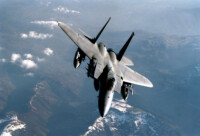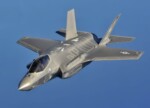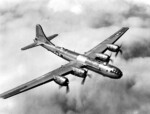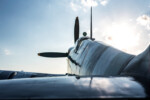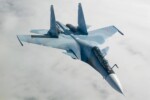The 10 Largest Aircraft Carriers in the World
28 March 2022 | Updated on February 05, 2024
Aircraft carriers are the largest weapons platform in a nation’s military arsenal and the nucleus of a modern armada. Aircraft carriers generally operate as seagoing airbases during conflict periods without depending on local authorities to provide ground bases for staging aircraft operations or interfering with their territorial sovereignty. In addition, aircraft carriers may be used as means of power projection to deter or subdue hostile nations without engaging in actual combat. According to the former United States Secretary of State, “an aircraft carrier is 100,000 tons of (big stick) diplomacy.”


Aircraft carriers have come a long way from the early twentieth-century wooden ships employed to launch balloons to present-day nuclear-powered supercarriers capable of carrying various fighter and reconnaissance aircraft, helicopters, and support aircraft.
The largest aircraft carriers are designed to operate as a military airbase providing full support for combat aircraft operations, with a full-length flight deck equipped with the machinery for safely parking, arming, launching, and recovering aircraft, an air-traffic-control unit, a munitions storage section, and a below-deck hangar for storing and maintaining aircraft. Large aircraft carriers also carry several defense systems for protection against submarine attacks, planes, and missile strikes.
The 10 Largest Aircraft Carriers in the World
At the time of writing, there are about 47 active aircraft carriers in operation with the navies of fourteen countries. Eight countries operate the 12 largest aircraft carriers globally, with the United States having the highest number on our list, followed by England, China, and India with two aircraft carriers. In contrast, Russia, France, and Italy have one each.
10. Cavour (C550)
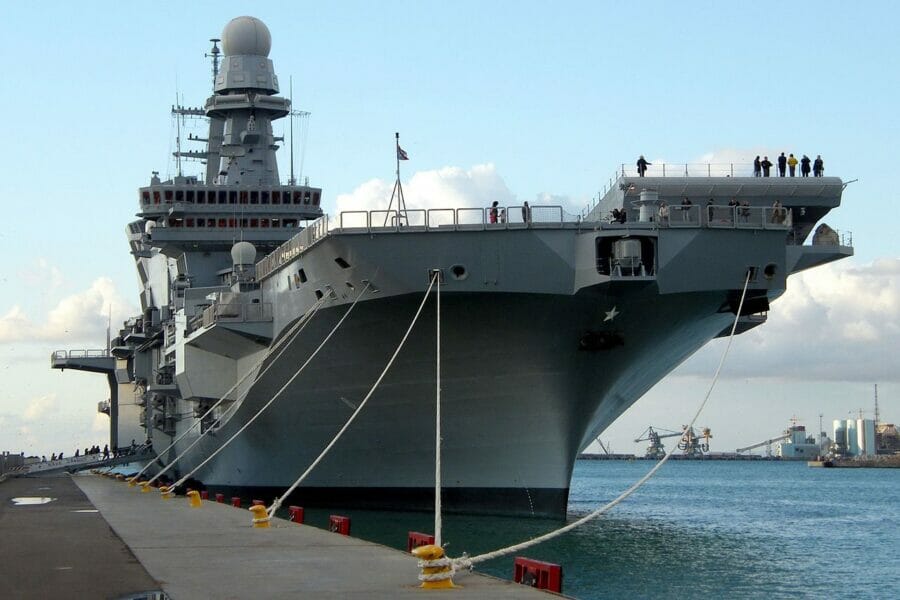

Country: Italy
Cost: €1.39 billion
Commissioned in 2008, the diesel and electric powered Cavour is the flagship of the Italian Navy (Marina Militare) and Italy’s second aircraft carrier after the Giuseppe Garibaldi. The vessel is designed for combat vertical or short take-off and landing (V/STOL) aircraft operations and a landing platform helicopter. Other functions of the aircraft carrier include military or civilian equipment transport, including heavy vehicles, and troop or civil personnel transportation. The Cavour is equipped with a command and control center for military and civil operations.
Its flight deck is built to accommodate fixed-wing fighter jets like AV-8B Harrier and JSF aircraft, including medium and heavy transport helicopters like the EH101, AB212, NH90, UH-101A ASH, and SH3D helicopters. A recent retrofit will allow the Cavour to accommodate sixteen F-35B Lightning fighter jets while the aging Harrier fleet is phased out.
The Cavour 30,000 square feet (2,800 m2) hangar space can hold 24 Ariete battle tanks, including 50 Dardo IFV and 100 Iveco light military vehicles. Its aft access ramps are rated 70 tons, while the internal aircraft elevators are 30 tons.
A large aircraft carrier carries a variety of defense systems for protection against external threats, and the Cavour is no exception. Its range of advanced defense systems includes batteries of A-43 Sylver launchers for surface-to-air missiles, 76/62 mm guns, and OTO Melara decoy launching systems.
Carrier details
- Type: Aircraft carrier
- Class: Cavour-class
- Commissioned: 2008
- Homeport: Taranto, Italy
- Crew: 1,202
- Displacement: 27,100 MT (30,000 MT full load)
- Length: 244 m (800.6 ft)
- Beam: 29.1 m (95.6 ft)
- Flight Deck: 232.60m x 34.5m (763.1ft x 113.2ft)
- Propulsion: COAG 2 x shafts, 4 x General Electric/Avio LM2500+ gas turbines producing 88,000 kW (118,000 bhp), 6 x Wärtsila CW 12V200 diesel generators producing 13,200 kW (17,700 bhp)
- Speed: +29 knots (33 mph, 54 kph)
- Range: 8,100 mi (13,000 km, 7,000 nmi)
9. Charles de Gaulle (R91)
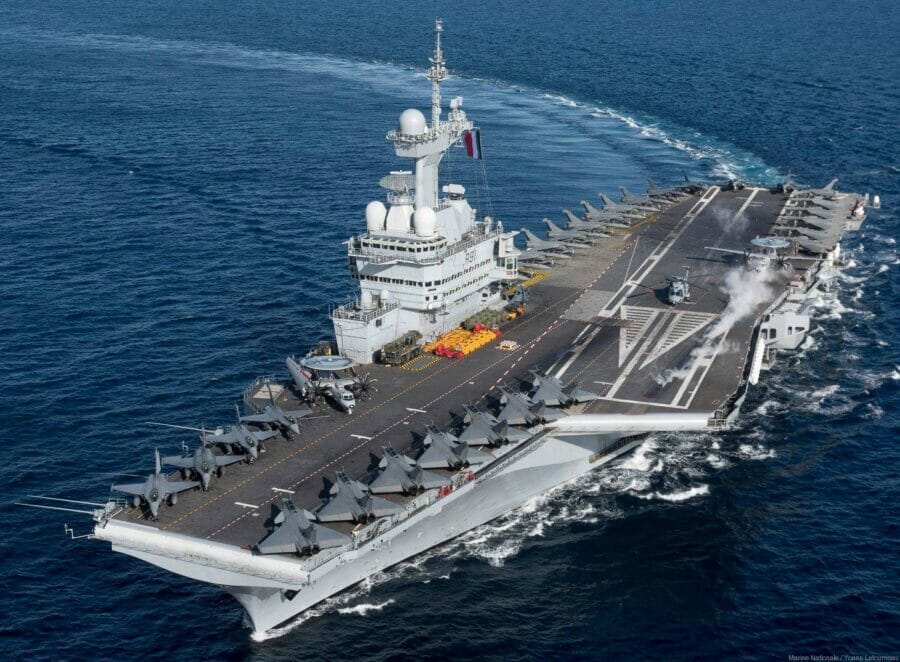

Country: France
Cost: €3 billion
The nuclear-powered aircraft carrier Charles de Gaulle (R91) is the French naval flagship and the tenth aircraft carrier operating with the French Navy (La Royale). It is the largest maritime vessel in Western Europe, the first French surface vessel with a nuclear power plant, and the only non-United States Navy nuclear-powered carrier. The Charles de Gaulle aircraft carrier design and engine choice provide the ship with the stealth and versatility required for its multi-role functions involving warfare and peacetime missions.
The Charles de Gaulle is a CATOBAR (Catapult Assisted Take-Off But Arrested Recovery) aircraft carrier. This is a smaller version of an aircraft launch and recovery system fitted on the US Nimitz class aircraft carriers. Its flight deck is equipped with two 75 m C13-3 steam catapults for catapult-assisted take-off and landing (recovery) of aircraft using arrestor wires. And the French nuclear-powered carrier is the only non-US aircraft carrier using the CATOBAR system.
The vessel can accommodate up to 40 fighter jets and fixed-wing ground support aircraft, including attack, search and rescue helicopters on the flight deck and below deck. Technical mishaps dogged early sea deployments of the Charles de Gaulle, which was five years behind schedule and over budget. But over time, Charles de Gaulle (R91) has earned respect and admiration of the French public and the seamen serving on board her during numerous combat deployments in the Middle East and Asia.
Carrier details
- Type: Aircraft carrier
- Class: Charles de Gaulle-class
- Commissioned: 2001
- Homeport: Toulon, France
- Crew: 1,350
- Displacement: 42,500 MT full load
- Length: 261.5 m (858 ft)
- Beam: 64.36 m (211.2 ft)
- Flight Deck: 232.60m x 34.5m (763.1ft x 113.2ft)
- Propulsion: 2 x Areva K15 pressurized water reactors (PWR), 150 MWt each, 2 x Alstom steam turbines producing 61 MW shaft power, 4 x diesel-electric engines
- Speed: 27 knots (31 mph, 50 kph)
- Range: Unlimited (20 – 25 years)
8. INS Vikrant
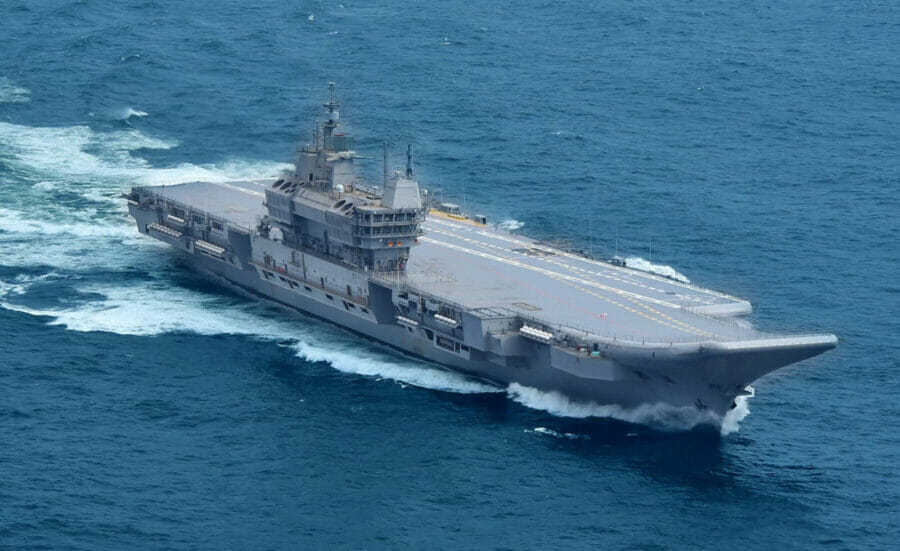

Country: India
Cost: $3.13 billion
The INS Vikrant is the first Indian-built aircraft carrier in the country’s history. The aircraft carrier, also known as Indigenous Aircraft Carrier 1 (IAC-1), is the pride and joy of the Indian Navy, and it is expected to commence naval operations in August 2022. IAC-1 is a multirole vessel designed to provide quick crisis response as part of a carrier battle group, protect Indian maritime economic interests, and provide humanitarian assistance to civilian populations during disasters.
Construction of the INS Vikrant was undertaken by the Cochin Shipyard Limited for the Indian Navy, and the design was done by the Indian Navy’s Directorate of Naval Design. The Vikrant was the first aircraft carrier project done by both organizations. Several Indian public and corporate organizations participated in designing and manufacturing the carrier’s propulsion systems, steel structure, and combat management system (CMS).
The INS Vikrant is a technologically advanced aircraft carrier capable of carrying large numbers of modern fighter jets and weapons systems. Its defense systems include long-range surface-to-air-missile (LRSAM).
The INS Vikrant is a STOBAR (Short Take-Off But Arrested Recovery) aircraft carrier with a steep ski jump for more efficient aircraft launches. The flight deck and hanger accommodate around thirty fixed-wing combat aircraft and heavy transport helicopters. The Indian Navy is now testing the Mikoyan MiG-29K fighter jet for operations from INS Vikrant. The Russian aircraft is the vessel’s proposed primary fighter. Other aircraft presently undergoing flight trials include the Dassault Rafale M, Boeing F/A-18E/F Super Hornet, Kamov Ka-31, and Westland Sea King helicopters.
Carrier details
- Type: Indigenous Aircraft Carrier 1 (IAC-1)
- Commissioned: 2022 (expected)
- Homeport: Rambilli, Visakhapatnam.
- Crew: 1,449 sailors, 196 officers
- Displacement: 45,000 MT (loaded displacement)
- Length: 262 m (860 ft)
- Beam: 62 m (203 ft)
- Flight Deck: 10,000 m2 (110,000 sq ft)
- Propulsion: 4 x General Electric LM2500+ gas turbine, 2 x Elecon COGAG gearbox
- Speed: 30 knots (35 mph, 56 kph)
- Range: 8,000 mi (15,000 km, 9,200 nmi)
7. INS Vikramaditya


Country: India
Cost (refurbished): $2.35 billion
India Navy’s largest aircraft carrier and flagship, the INS Vikramaditya, is a modified warship originally in service with the Russian Navy. However, after its decommissioning in 1996, the Indian government expressed interest in purchasing the Kiev-class aircraft carrier for $2.35. It entered the service of the Indian Navy in June 2014 after extensive refurbishments.
The INS Vikramaditya was retrofitted into a STOBAR (Short Take-Off But Arrested Recovery) aircraft carrier. The retrofitting process involved removing the ship’s defense and missile systems from the foredeck to make room for the STOBAR mechanism. Additional upgrades to the carrier include strengthening the bulbous bow, new air conditioning, refrigeration plants, new aircraft and munitions lifts, modern flight deck lighting systems, two reverse osmosis plants, and cabling upgrades.
The INS Vikramaditya STOBAR flight deck can take a variety of 30 fighter jets and transport helicopters, which include MiG 29Ks, Sea Harrier FA2s, Kamov 31 radar picket Airborne Early Warning (AEW) helicopters, Kamov 28 naval helicopters, Sea King heavy transport helicopters, ALH-Dhruv multirole helicopters, and Chetak helicopters. The carrier’s defense systems include anti-ship missiles, close-in-weapon systems CIWS), Barak 8 long-range air-defense system (LR-SAM).
A naval flagship quill is not complete without a state-of-the-art electronic warfare suite and sensors, including long-range air surveillance radar capable of detecting enemy threats within a 500-kilometer radius.
Carrier details
- Type: Aircraft carrier
- Class: Modified Kiev-class
- Commissioned: 2013
- Homeport: INS Kadamba, Karwar
- Crew: 1,500 sailors, 110 officers
- Displacement: 45,400 MT (total load displacement)
- Length: 284 m (932 ft)
- Beam: 61 m (200 ft)
- Flight Deck: 284 m x 60 m (932ft x 197ft)
- Propulsion: 8 turbo-pressurized boilers, four shafts, four geared steam turbines producing 134,226 kW (180,000 bhp)
- Speed: 30 knots (35 mph, 56 kph)
- Range: 15,534 mi (25,000 km, 13,500 nmi)
6. Liaoning (16)
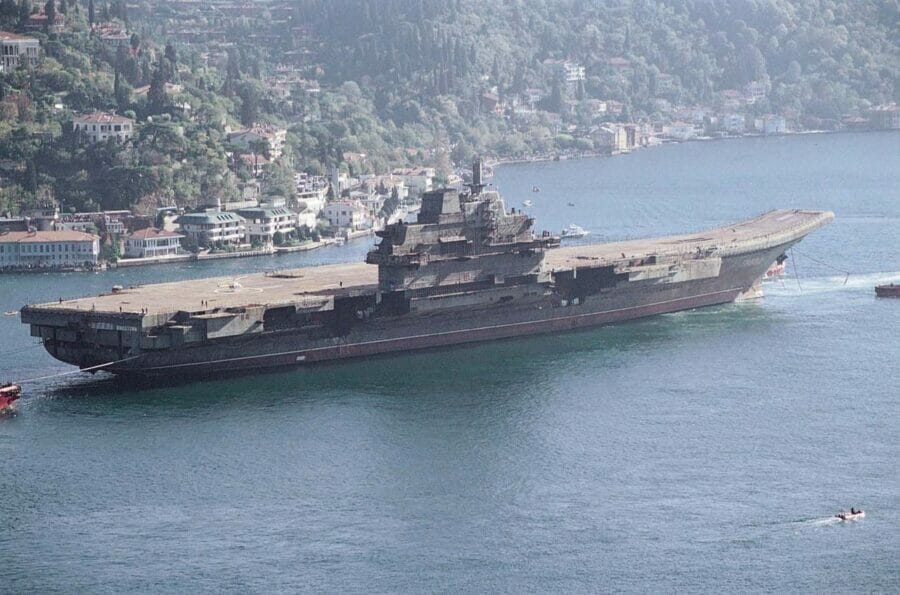

Country: China
The Liaoning is the second aircraft carrier on our list purchased from original owners and refurbished before entering the service of its current operator, the People’s Liberation Army Navy (PLAN). The vessel’s construction began in 1985 as a Soviet Union Kuznetsov-class aircraft cruiser. It was intended as the sister ship to the aircraft carrier Admiral Kuznetsov. Still, authorities halted the project after the fall of communism, and the half-finished ship was put up for sale by the Ukrainian government.
In 1998, the vessel was auctioned for $20 million to a mysterious Macau-based company, the Chong Lot Travel Agency, that would convert the carrier into a floating hotel and casino complex. However, the vessel ended up in China and was laid up at the Dalian naval shipyard, where it was refurbished and commissioned into the PLAN service. Initial plans by the Chinese navy were to use the Liaoning as a training, experimental, and research ship for sailors and navy pilots to become accustomed to aircraft carrier operations. But in 2019, Chinese authorities gave Liaoning active combat status.
According to details revealed by the Shanghai Morning Post, the Liaoning could carry 36 aircraft on its flight deck and enlarged hangar. These include 24 Shenyang J-15 fighter jets, 24 Shenyang J-15 fighters, six Changhe Z-18F anti-submarine warfare (ASW) helicopters, four Changhe Z-18J airborne early warning (AEW) helicopters, and a couple of Harbin Z-9C rescue helicopters. Defense systems on the Liaoning include Types 1130 rotary cannons and HQ-10 short-range surface-to-air missiles.
Carrier details
- Type: Aircraft carrier
- Class: Type 001, Kuznetsov-class (modified)
- Commissioned: 2012
- Homeport: Yuchi Naval Base, Huangdao
- Crew: 1,960 sailors, 40 flagstaff
- Displacement: 43,000 tons (light), 60,900 (total load displacement)
- Length: 306.4 m (1,005.3 ft)
- Beam: 74.4 m (244.1ft)
- Propulsion: Steam turbines, eight boilers, 4 shafts, 200,000 hp (150 MW), 4 × 50,000 hp (37 MW) turbines, 9 × 2,011 hp (1,500 kW) turbogenerators, 6 × 2,011 hp (1,500 kW) diesel generators, 4 × fixed pitch propellers
- Speed: 32 knots (37 mph, 59 kph)
- Range: 3,850 mi (7,130 km, 3,850 nmi)
5. Admiral Kuznetsov


Country: Soviet Union, Russia
The Admiral Kuznetsov is a Russian Navy Kuznetsov-class aircraft cruiser/carrier. Built by the Mykolaiv South shipyard on Ukraine’s Black Sea, the vessel was commissioned in the service of the Soviet Navy in January 1991 as the lead ship of the proposed two-ship Kuznetsov class. However, plans to build a sister ship named the Riga were abandoned halfway through construction, and the hull was subsequently bought, completed, and commissioned by the Chinese navy as the Liaoning.
The Admiral Kuznetsov uses a bow ski-jump with a 12° incline and arrestor wires for fixed-wing aircraft take-off and recovery instead of steam catapults. Its 14,700 flight deck area was designed to operate Su-27K and MiG-29K fighter jets, the Yak-41, and the heavier Yak-43 short take-off and vertical landing (STOVL) fighters. However, aircraft on the carrier during its sea deployments include 18 Su-33 and 6 MiG-29K fighter jets, 4 Ka-31 and 4 Ka-27S/27ld32/PLO helicopters. Other fixed-wing aircraft deployed on Admiral Kuznetsov include Su-25UTG/UBP STOVL fighter jets.
As expected of the flagship of the Russian Navy, Admiral Kuznetsov carries a plethora of long/short-range air defense and anti-submarine weaponry. They include AK-630 AA guns, 8 CADS-N-1 Kashtan CIWS air defense gun and missile systems, 12 P-700 Granit anti-ship cruise missiles in silos installed beneath the flight deck, and an RBU-12000 UDAV-1 ASW anti-torpedo rocket launch system. Additional weapons to be installed on the Kuznetsov after its retrofitting include a Pantsir-M/EM air defense system developed by Tula KBP and a couple of GSh-6-30K/AO-18KD 30mm six-barrel rotary cannons.
Problems with the vessel’s propulsion system resulted in unreliability issues. According to Business Insider, the Kuznetsov was always accompanied by a special tugboat in the event of a breakdown. The ship was also deteriorating with plumbing issues resulting in non-functioning toilets. Admiral Kuznetsov is undergoing repairs and retrofitting to modernize its systems and ensure a more efficient operation. However, a series of accidents while in a floating dry dock damaged the vessel killing two workers. The carrier is expected to return to active status in mid-2023.
Carrier details
- Type: Aircraft cruiser/aircraft carrier
- Class: Kuznetsov-class
- Commissioned: 1991
- Homeport: Severomorsk, Russia
- Crew: 1,690 sailors, 40 flagstaff
- Displacement: 53,000 tons (standard), 58,600 tons (full load)
- Length: 305 m (1,000.8 ft)
- Beam: 72 m (236.3 ft)
- Flight Deck Area: 14 700 m²
- Propulsion: Steam turbines, 8 turbo-pressurized boilers, 4 shafts, 200,000 hp (150 MW), 4 x 50,000 hp (37 MW) turbines, 9 x 2,011 hp (1,500 kW) turbogenerators, 6 x 2,011 hp (1,500 kW) diesel generators, 4 x fixed pitch propellers
- Speed: 29 knots (33 mph, 54 kph)
- Range: 9,800 mi (15,700 km, 8,500 nmi)
4. Shandong (17)
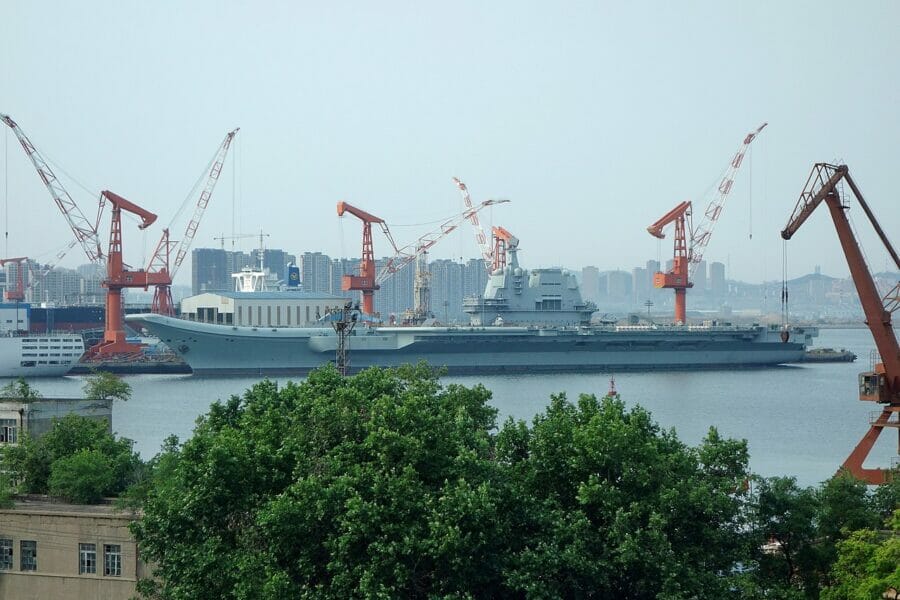

Country: China
The Shandong (17) is the People’s Liberation Army Navy’s (PLAN) flagship. It is the PLAN’s second aircraft carrier, its largest, and the first aircraft carrier to be domestically designed and built in China. The Shandong is a STOBAR (Short Take-Off But Arrested Recovery) aircraft carrier like its predecessor, the Liaoning.
Although the construction of the Shandong was kept a closely guarded secret by the PLAN, images of the vessel under construction at the Dalian Shipbuilding yard soon surfaced on news channels around the globe. The ship was designed to provide more efficient operations over the Liaoning. The engineers made several improvements, including a runway ski jump angled at 12° instead of a 14° ski jump on the Liaoning. Also, a slightly smaller island featuring a second glazed deck allows flight control operations to take place separately from the carrier’s bridge. Extended pontoons on the rear-starboard quarter freeing up space for an additional eight fighter jets and helicopters on the flight deck were installed on the Shandong.
Other improvements include an enlarged hangar capable of holding 32 Shenyang J-15 jet fighters, Changhe Z-18 medium-lift helicopters, and 4 Harbin Z-9 helicopters. The vessel electronic warfare suite consists of four active electronically scanned arrays (AESAs) for the improved Type 346A S-band radar (Type 346 radar). And it has a larger air wing than its predecessor, the Liaoning, consisting of eight additional aircraft.
Carrier details
- Type: Aircraft Carrier
- Class: Type 002
- Commissioned: 2013
- Homeport: Sanya, Hainan Province
- Crew: 1,960
- Displacement: 55,000 tons (standard), 70,000 tons (full load)
- Length: 305 m (1,000.8 ft)
- Beam: 75 m (246.1 ft)
- Flight Deck: 304.5 m x 72 m (999.01 ft x 236.22 ft)
- Propulsion: Conventional steam turbines, 4 shafts
- Speed: 31 knots (36 mph, 57 kph)
- Range: 16,119 mi (25,928 km, 14,007 nmi)
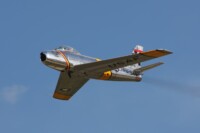

Recommended
Can Civilians Buy Fighter Jets?
3. Queen Elizabeth Class
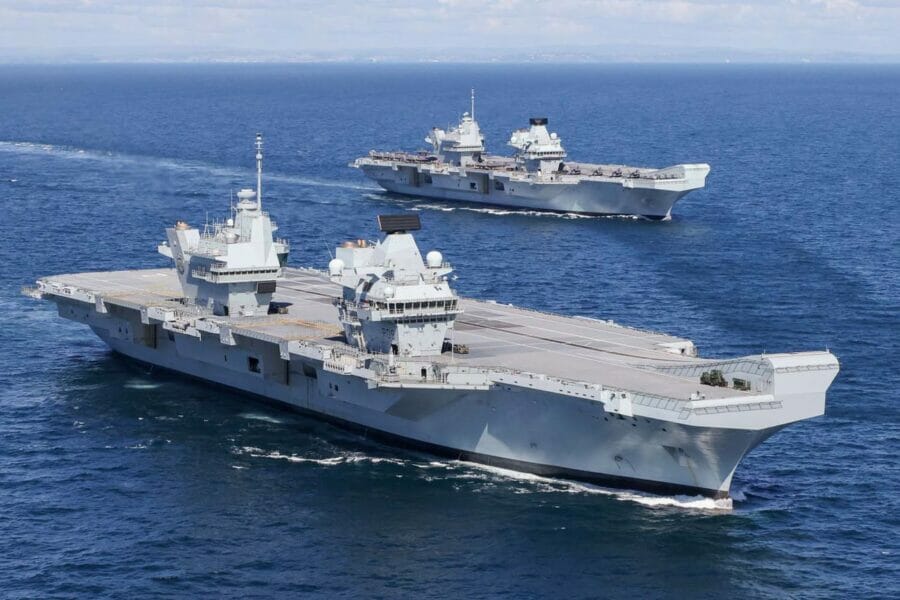

Country: United Kingdom
Cost for 2 units: £7.6 billion
The Queen Elizabeth class is a UK Carrier Strike Group consisting of two ships, the HMS Queen Elizabeth (leadership) and HMS Prince of Wales. The two vessels replacing the decommissioned Invincible class carriers are the third-largest aircraft carriers in the world and the largest warships ever built for the UK Royal Navy.
Constructing the leviathans required a new and revolutionary approach to shipbuilding. Enormous sections of the ships, each bigger than a Daring-class destroyer, were built at different locations around the UK and floated on barges to a special dry dock at Rosyth, where all the pieces were assembled.
The Queen Elizabeth class carriers have two islands, one for flight control operations and the other for ship navigation. Both islands could perform each other’s functions if one is destroyed or disabled by accident or through enemy action.
Both vessels have an expansive flight deck that features a ski jump but lacks aircraft launch mechanisms or arrestors because it is designed for Short-Take-Off and Vertical Landing (STOVL) aircraft operations. The flight and hangar deck can accommodate the standard air group of 36 F-35B joint strike fighters and 4 EH101 Merlin helicopters with a maximum sortie rate of 110 joint combat aircraft and maritime surveillance and control aircraft (MASC) per day.
To protect itself against attacks, the carrier-class is armed with the Phalanx close-in-weapons-system CIWS. It’s 30mm rapid-fire computer and radar-controlled Gatlin gun can fire 3,000 rounds a minute, providing a lethal last line of defense for the ships. The assortment of radar and electronic surveillance systems on the Queen Elizabeth class include BAE Systems Insyte (with Qinetiq), ARTISAN 3D E/F-band new generation maritime medium-range radar (MRR), and Selex Communications identification friend or foe (IFF) systems.
Carrier details
- Type: Aircraft Carrier
- Class: Queen Elizabeth class
- Commissioned: 2017 HMS Queen Elizabeth, 2019 HMS Prince of Wales
- Homeport: Portsmouth HMS Queen Elizabeth, Liverpool HMS Prince of Wales
- Crew: 679
- Displacement: 65,000 tons (standard)
- Length: 280 m (920 ft)
- Beam: 73 m (240 ft)
- Flight Deck: 280 m x 70 m (919 ft x 230 ft)
- Propulsion: 2 x Rolls-Royce Marine Trent MT30 36 MW (48,000 hp) gas turbine engines steam turbines, 4 x Wärtsilä 16V38 marine diesel engines 11.6 MW (15,600 hp)
- Speed: 32 knots (37 mph, 59 kph)
- Range: 12,000 mi (19,000 km, 10,000 nmi)
2. Nimitz Class
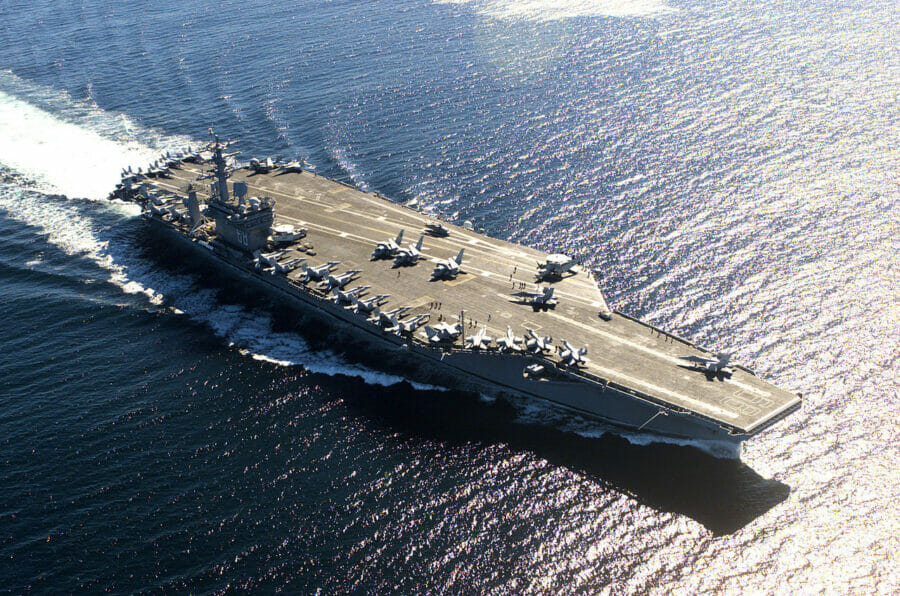

Country: United States
Cost: $4.5 – $6.5 billion per unit
The Nimitz class consists of ten massive United States Navy nuclear-powered aircraft carriers with successive hull numbers running from CVN-68 to CVN-77. This carrier-class was the largest aircraft carrier in the world until the commissioning of the USS Gerald R. Ford in 2017.
Nimitz class carriers are towering giants, and they have 25 decks making them as tall as an office building. Initially designed as attack aircraft carriers, the ships in the class have since undergone retrofits designed to provide multirole capabilities, including air and land missile strikes, anti-submarine operations, mine laying, sea blockades, and enforcing no-fly-zones.
The angled 4.5-acre flight deck uses a CATOBAR arrangement with steam catapults and arrestor wires for aircraft launch and recovery. It can accommodate up to 90 carrier wing aircraft and helicopters with 2 elevators conveying aircraft from the hangar to the flight deck.
Defensive weapons and systems can be deployed on Nimitz class carriers to deter external threats. These include 20 mm Phalanx CIWS cannons and NATO RIM-7 Sea Sparrow missiles. Some vessels have 64 mm (2.5 inches) Kevlar armor installed over vital areas. Radar and electronic warfare and countermeasures on Nimitz class carriers include AN/SLQ-32(V) Radar jamming and deception systems, AN/SLQ-25 Nixie torpedo countermeasures system, and Sippican SRBOC (super rapid bloom off-board chaff) six-barrel MK36 decoy launchers.
Carrier details
- Type: Aircraft Carrier
- Class: Nimitz-class
- Commissioned: 1975
- Homeport: Bremerton, Washington (USS Nimitz)
- Crew: 3,532
- Displacement: 101,600 – 106,300 tons
- Length: 332.8 m (1,092 ft)
- Beam: 76.8 m (252 ft)
- Flight Deck: 333 m x 77 m (1,092.52 ft x 253 ft)
- Propulsion: 2 x Westinghouse A4W nuclear reactors, 4 x steam turbines, 4 x shafts
- Speed: 30 knots (35 mph, 56 kph)
- Range: Unlimited distance, 20 -25 years
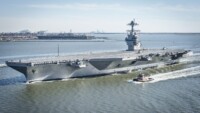

Related
How Long is an Aircraft Carrier?
1. Gerald R Ford Class
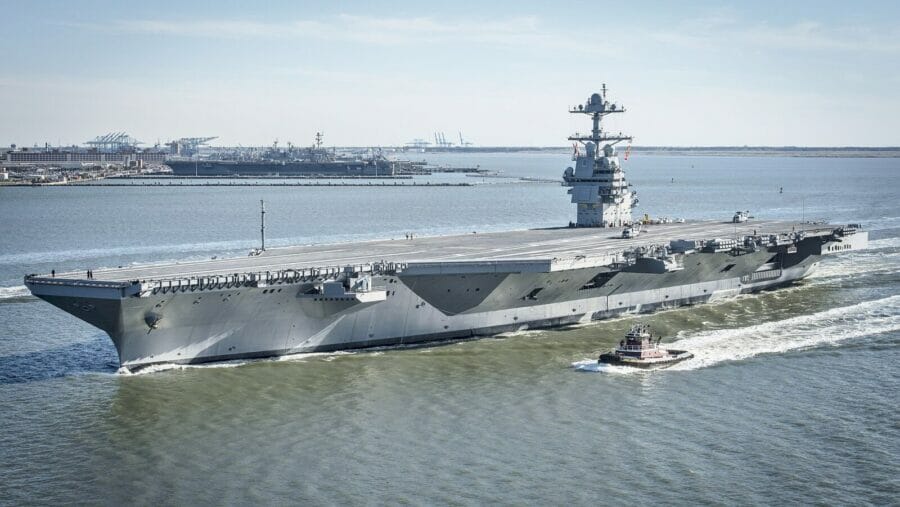

Country: United States
Cost: $12.998 (unit cost), $37.30 billion(program cost)
The number one spot on our list of 10 largest aircraft carriers in the world goes to the Gerald R. Ford-class aircraft carrier. This behemoth consists of ten nuclear-powered carriers built for the United States Navy. Over time, the Gerald R. Ford-class carriers will replace the aging Nimitz-class carriers.
The Gerald Ford-class is a new generation of aircraft carriers designed to reduce the high operating costs of existing carriers and improve efficiency by replacing current systems with automation and new technology resulting in a reduced crew. It also features the most advanced aircraft launch system in the world, the Electromagnetic Aircraft Launch System (EMALS), and a modern arresting gear instead of the conventional steam catapults and arrestor wires.
Improvements to the new carrier-class include a massive aircraft parking and storage capacity. The Gerald Ford-class aircraft carrier can accommodate ninety aircraft, including fighter jets, airborne early warning (AEW) aircraft, transport and utility helicopters, and unmanned aerial vehicles (UAVs).
An extensive range of defense and radar systems is available, including electronic countermeasures. A significant innovation is the development of stealth features that will reduce the massive carrier’s radar cross-section, making them harder to detect on the enemy radar during combat operations.
Several facilities are designed to use the crew during peacetime and combat missions. One of those is the full-size hospital with intensive care and emergency units and a 41-bed hospital.
Carrier details
- Type: Aircraft Carrier
- Class: Gerald R Ford-class
- Commissioned: 2017
- Homeport: Norfolk, Virginia (USS Gerald R Ford)
- Crew: 2,600
- Displacement: 101,000 tons
- Length: 333 m (1,092 ft)
- Beam: 77 m (252 ft)
- Flight Deck: 333 m x 77 m (1,092 ft × 252 ft)
- Propulsion: 2 x Bechtel A!B PWR nuclear reactors, 2 x shafts
- Speed: 30 knots (35 mph, 56 kph)
- Range: Unlimited distance, 50 years




















